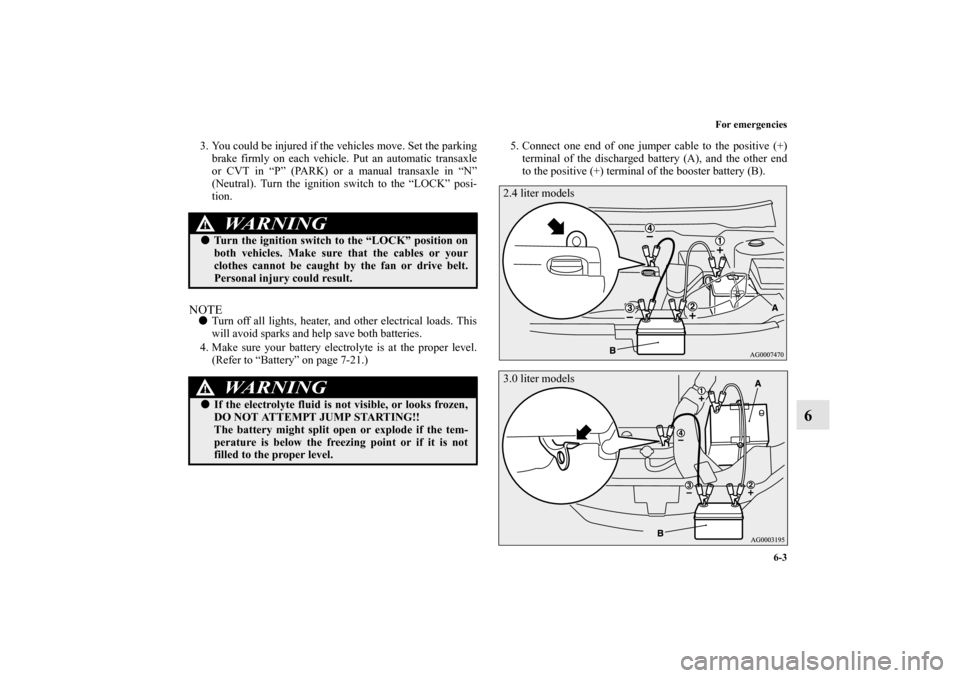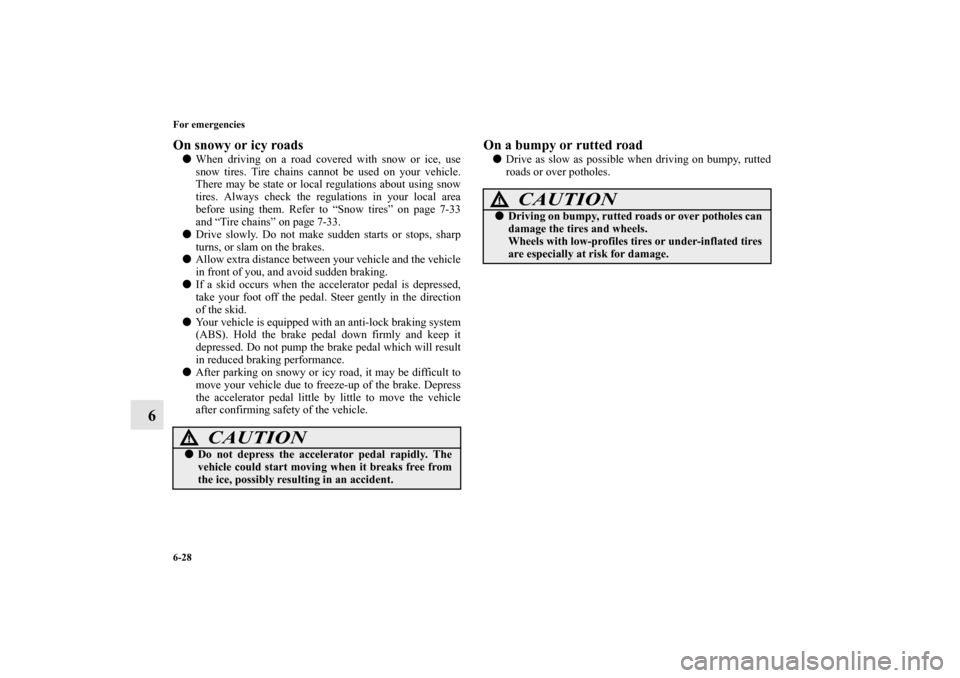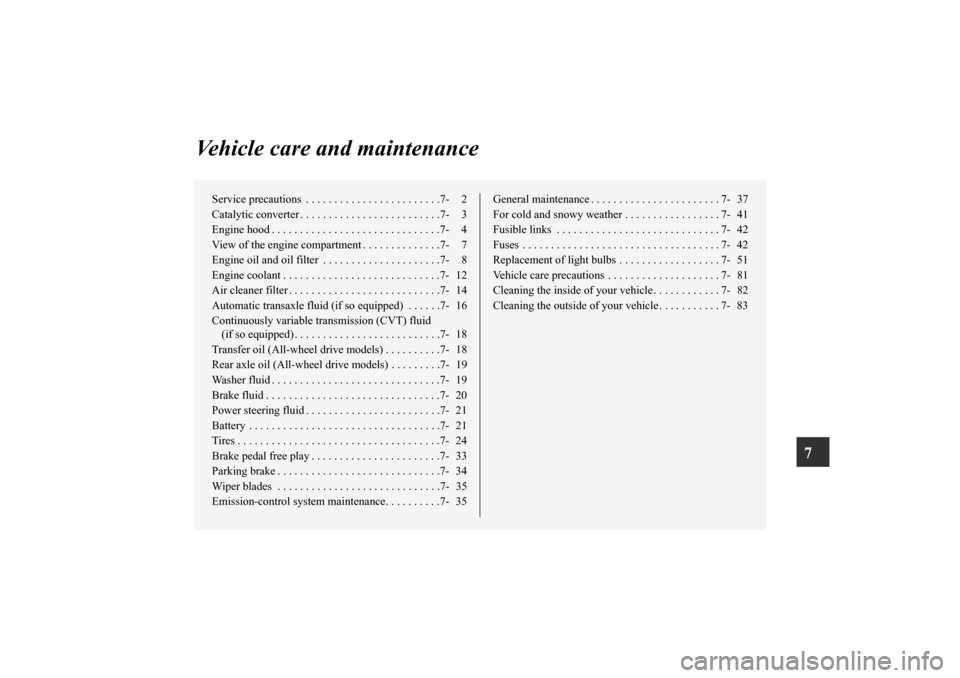Page 424 of 714

Driving safety
4-21
4
When towing at high altitudes, engine coolant and automatic
transaxle oil will overheat at a lower temperature than at nor-
mal altitudes.
If you turn your engine off immediately after towing at high
altitude on steep uphill grades, your vehicle may show signs
similar to overheating. To avoid this, let the engine run while
parked (preferably on level ground) with the automatic tran-
saxle in the “P” (PARK) position for a few minutes before turn-
ing the engine off.
�If the engine coolant temperature indicator flashes on
the information screen in the multi-information display or
the engine power drops suddenly, refer to “Engine over-
heating” on page 6-5.
�If the warning display or warning display illumi-
nates, refer to “Warning display” on page 3-96.Driving on hillsReduce speed and downshift before you start down a long or
steep downgrade. If you don’t shift down, over using the
brakes can cause reduced brake efficiency.
You can tow in “D” (DRIVE) position. You may want to shift
the selector lever to the 3rd or a lower position, under heavy
loads or hilly conditions.
ParkingAlways place chocks or blocks under both the vehicle and
trailer wheels when parking. Be sure that the parking brake is
firmly set and that the selector lever is in the “P” (PARK) posi-
tion. Avoid parking on a hill with a trailer, but if it cannot be
avoided, do so only after performing the following:
1. Apply the brakes and keep them applied.
2. Have someone place chocks or blocks under both the
vehicle and trailer wheels.
3. When the chocks or blocks are in place, release your
brakes slowly until the chocks or blocks absorb the load.
4. Apply the parking brake firmly.
5. Set the selector lever to the “P” (PARK) position and turn
off the engine.
BK0122500US.book 21 ページ 2010年5月12日 水曜日 午前11時11分
Page 425 of 714
4-22 Driving safety
4
When restarting out after parking on a hill:
1. Check that the selector lever is set to the “P” (PARK)
position.
2. Start the engine. Be sure to keep the brake pedal
depressed.
3. Set the selector lever to the “D” (DRIVE) position or “R”
(REVERSE) position.
4. Release the parking brake and brake pedal and slowly pull
or back away from the chocks or blocks. Stop and apply
your brakes.
5. Have someone retrieve the chocks or blocks.BK0122500US.book 22 ページ 2010年5月12日 水曜日 午前11時11分
Page 572 of 714

For emergencies
6-3
6
3. You could be injured if the vehicles move. Set the parking
brake firmly on each vehicle. Put an automatic transaxle
or CVT in “P” (PARK) or a manual transaxle in “N”
(Neutral). Turn the ignition switch to the “LOCK” posi-
tion.NOTE�Turn off all lights, heater, and other electrical loads. This
will avoid sparks and help save both batteries.
4. Make sure your battery electrolyte is at the proper level.
(Refer to “Battery” on page 7-21.)5. Connect one end of one jumper cable to the positive (+)
terminal of the discharged battery (A), and the other end
to the positive (+) terminal of the booster battery (B).
WA R N I N G
!�Turn the ignition switch to the “LOCK” position on
both vehicles. Make sure that the cables or your
clothes cannot be caught by the fan or drive belt.
Personal injury could result.
WA R N I N G
!�If the electrolyte fluid is not visible, or looks frozen,
DO NOT ATTEMPT JUMP STARTING!!
The battery might split open or explode if the tem-
perature is below the freezing point or if it is not
filled to the proper level.
2.4 liter models3.0 liter models
BK0122500US.book 3 ページ 2010年5月12日 水曜日 午前11時11分
Page 579 of 714
6-10 For emergencies
6How to change a tire
N00836900747
Before changing a tire, first stop your vehicle in a safe, flat
location.
1. Park the vehicle on level and stable ground.
2. Be sure that the parking brake is firmly set and that the
selector lever is in the “P” (PARK) position.
3. Turn on the hazard flashers and turn the ignition switch to
the “LOCK” position.
4. Set up a warning triangle, flashing signal light, etc., at an
adequate distance from the vehicle, and have all your pas-
sengers leave the vehicle.5. To prevent the vehicle from rolling when it is raised on the
jack, place chocks or blocks (A) in front of and behind the
tire that is diagonally opposite from the tire (B) you are
changing.BK0122500US.book 10 ページ 2010年5月12日 水曜日 午前11時11分
Page 595 of 714

6-26 For emergencies
6
Towing the vehicle by a tow truck
Towing a front-wheel drive vehicle with front wheels off
the ground (Type C)Release the parking brake.
Set the selector lever to the “N” (NEUTRAL) position.
CAUTION
!�This vehicle must not be towed by a tow truck using
sling lift type equipment (Type A) as illustrated.
Using a sling lift will damage the bumper and front
end.�This vehicle must not be towed with the driving
wheels on the ground (Type B) as illustrated.
This could result in the driving system damage.�Do not tow all-wheel drive vehicles with the rear
wheels on the ground (Type C) as illustrated. This
could result in the driving system damage or vehicle
may jump at the carriage.
If you tow all-wheel drive vehicles, use only Type D
or E equipment.
All-wheel-drive vehicles cannot be towed with only
the front or rear tires on the ground even if it is in
“2WD” or “TARMAC” drive mode.�[For front-wheel drive vehicle equipped with the
active stability control (ASC)]
If the vehicle is towed with the ignition switch in the
“ON” position and only the front wheels raised off
the ground (Type C), the ASC may operate, result-
ing in an accident. When towing the vehicle with the
front wheels raised, keep the ignition switch in the
“LOCK” or “ACC” position.
BK0122500US.book 26 ページ 2010年5月12日 水曜日 午前11時11分
Page 597 of 714

6-28 For emergencies
6
On snowy or icy roads�When driving on a road covered with snow or ice, use
snow tires. Tire chains cannot be used on your vehicle.
There may be state or local regulations about using snow
tires. Always check the regulations in your local area
before using them. Refer to “Snow tires” on page 7-33
and “Tire chains” on page 7-33.
�Drive slowly. Do not make sudden starts or stops, sharp
turns, or slam on the brakes.
�Allow extra distance between your vehicle and the vehicle
in front of you, and avoid sudden braking.
�If a skid occurs when the accelerator pedal is depressed,
take your foot off the pedal. Steer gently in the direction
of the skid.
�Your vehicle is equipped with an anti-lock braking system
(ABS). Hold the brake pedal down firmly and keep it
depressed. Do not pump the brake pedal which will result
in reduced braking performance.
�After parking on snowy or icy road, it may be difficult to
move your vehicle due to freeze-up of the brake. Depress
the accelerator pedal little by little to move the vehicle
after confirming safety of the vehicle.
On a bumpy or rutted road�Drive as slow as possible when driving on bumpy, rutted
roads or over potholes.
CAUTION
!�Do not depress the accelerator pedal rapidly. The
vehicle could start moving when it breaks free from
the ice, possibly resulting in an accident.
CAUTION
!�Driving on bumpy, rutted roads or over potholes can
damage the tires and wheels.
Wheels with low-profiles tires or under-inflated tires
are especially at risk for damage.
BK0122500US.book 28 ページ 2010年5月12日 水曜日 午前11時11分
Page 598 of 714

7
Vehicle care and maintenance
Service precautions . . . . . . . . . . . . . . . . . . . . . . . .7- 2
Catalytic converter . . . . . . . . . . . . . . . . . . . . . . . . .7- 3
Engine hood . . . . . . . . . . . . . . . . . . . . . . . . . . . . . .7- 4
View of the engine compartment . . . . . . . . . . . . . .7- 7
Engine oil and oil filter . . . . . . . . . . . . . . . . . . . . .7- 8
Engine coolant . . . . . . . . . . . . . . . . . . . . . . . . . . . .7- 12
Air cleaner filter . . . . . . . . . . . . . . . . . . . . . . . . . . .7- 14
Automatic transaxle fluid (if so equipped) . . . . . .7- 16
Continuously variable transmission (CVT) fluid
(if so equipped) . . . . . . . . . . . . . . . . . . . . . . . . . .7- 18
Transfer oil (All-wheel drive models) . . . . . . . . . .7- 18
Rear axle oil (All-wheel drive models) . . . . . . . . .7- 19
Washer fluid . . . . . . . . . . . . . . . . . . . . . . . . . . . . . .7- 19
Brake fluid . . . . . . . . . . . . . . . . . . . . . . . . . . . . . . .7- 20
Power steering fluid . . . . . . . . . . . . . . . . . . . . . . . .7- 21
Battery . . . . . . . . . . . . . . . . . . . . . . . . . . . . . . . . . .7- 21
Tires . . . . . . . . . . . . . . . . . . . . . . . . . . . . . . . . . . . .7- 24
Brake pedal free play . . . . . . . . . . . . . . . . . . . . . . .7- 33
Parking brake . . . . . . . . . . . . . . . . . . . . . . . . . . . . .7- 34
Wiper blades . . . . . . . . . . . . . . . . . . . . . . . . . . . . .7- 35
Emission-control system maintenance. . . . . . . . . .7- 35General maintenance . . . . . . . . . . . . . . . . . . . . . . . 7- 37
For cold and snowy weather . . . . . . . . . . . . . . . . . 7- 41
Fusible links . . . . . . . . . . . . . . . . . . . . . . . . . . . . . 7- 42
Fuses . . . . . . . . . . . . . . . . . . . . . . . . . . . . . . . . . . . 7- 42
Replacement of light bulbs . . . . . . . . . . . . . . . . . . 7- 51
Vehicle care precautions . . . . . . . . . . . . . . . . . . . . 7- 81
Cleaning the inside of your vehicle . . . . . . . . . . . . 7- 82
Cleaning the outside of your vehicle . . . . . . . . . . . 7- 83
BK0122500US.book 1 ページ 2010年5月12日 水曜日 午前11時11分
Page 631 of 714
7-34 Vehicle care and maintenance
7Parking brake
N00940400164
Parking brake lever strokeCheck the parking brake lever travel occasionally. To check
this, pull the lever up slowly and count the number of clicks of
the ratchet. You should feel the parking brake grab between 3
to 5 notches (clicks).
Also check to see if the lever stays gripped by the ratchet after
pulling.
Parking brake break-inBreak-in the parking brake linings whenever the brake perfor-
mance of the parking brake is insufficient or whenever the
parking brake linings and/or drum/discs are replaced, in order
to assure the best brake performance.
This procedure is described in the vehicle service manual and
can be carried out by an authorized Mitsubishi Motors dealer
WA R N I N G
!�Continued operation of the vehicle with the parking
brake lever out of adjustment may result in the vehi-
cle moving when unattended.
BK0122500US.book 34 ページ 2010年5月12日 水曜日 午前11時11分